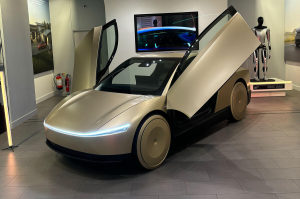
IT Home reported on November 20 that Tesla’s self-driving coupe Cybercab made its debut in the UK, showcasing the company’s vision of building a global self-driving fleet.
The vehicle, officially called Cybercab, was just unveiled at Warner Bros. Studios in California alongside another 20-passenger self-driving van called Robovan, and it’s now on display at London’s Westfield shopping mall, a month after it was unveiled.
Neither concept has a steering wheel or pedals, and runs on artificial intelligence and cameras rather than the more common lidar sensors and built-in mapping software. Musk said they will also be able to charge wirelessly, so there will be no need for charging ports like Tesla’s traditional cars.
At an exclusive event in California called “We Robot,” Musk touted the benefits of autonomous driving technology: “Think about the total time people spend in the car, and they can use this saved time to read books, watch movies, work, etc.”
To this end, the Cybercab’s cockpit adopts a simple design, with two seats, two cup holders, an armrest and a large central touchscreen similar to the Model 3. The trunk space is spacious, but like the angular Cybertruck pickup, the Cybercab has no rear window.
Musk said Tesla hopes to start production of the Cybercab in 2027 and sell it to consumers for an estimated price of $30,000 (IT Home Note: Currently about 217,000 yuan). But he did not give a clear timeline for the mass production of Robovan, nor did he confirm whether the two models would be available outside the United States.
Before putting the two new self-driving cars into production, Tesla plans to have the “unsupervised” FSD technology certified and applied to the Model 3 and Model Y models by 2025.

